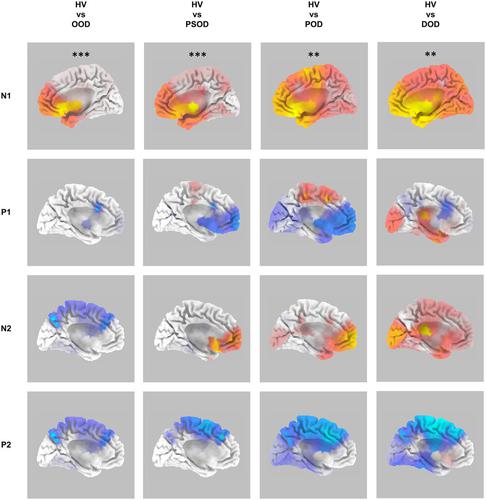当前位置:
X-MOL 学术
›
Ann. N. Y. Acad. Sci.
›
论文详情
Our official English website, www.x-mol.net, welcomes your feedback! (Note: you will need to create a separate account there.)
Comparing biomechanics and neurophysiology between different phenotypes of patients with oropharyngeal dysphagia
Annals of the New York Academy of Sciences ( IF 5.2 ) Pub Date : 2024-02-12 , DOI: 10.1111/nyas.15103 Noemí Tomsen 1, 2 , Omar Ortega 1, 2 , Pere Clavé 1, 2
Annals of the New York Academy of Sciences ( IF 5.2 ) Pub Date : 2024-02-12 , DOI: 10.1111/nyas.15103 Noemí Tomsen 1, 2 , Omar Ortega 1, 2 , Pere Clavé 1, 2
Affiliation

|
The pathophysiology of oropharyngeal dysphagia (OD) across patient phenotypes may differ. The aim of this study was to compare the biomechanics and neurophysiology of swallowing between healthy volunteers (HVs) and patients with dysphagia as a consequence of aging (OOD), post-stroke (PSOD), Parkinson's disease (POD), or dementia (DOD). A retrospective study including 35 HVs and 109 OOD, 195 PSOD, 78 POD, and 143 DOD patients was performed. Videofluoroscopic data of signs of impaired efficacy and safety, penetration–aspiration scale (PAS) score, and the biomechanics of laryngeal vestibule closure (LVC) and opening (LVO) and of upper esophageal sphincter opening (UESO) were collected. Neurophysiology was assessed with pharyngeal sensory evoked potentials and neurotopography maps. All OD phenotypes showed signs of impaired efficacy and safety of swallowing, increased PAS score (p < 0.001), and delayed time to LVC (p < 0.0001). OOD (p < 0.0001), PSOD (p < 0.0001), and POD (p = 0.0065) patients also had delayed time to LVO, and OOD (p = 0.0062) and DOD (p = 0.0016) patients to UESO. Regarding neurophysiology, all phenotypes presented impaired pharyngeal sensitivity, a significant reduction in cortical activation, and impaired sensory input integration. Additionally, only PSOD was associated with impaired conduction of sensory stimuli. In conclusion, we found common but also specific pathophysiological elements. These results improve our understanding of OD pathophysiology and may help pave the way for phenotype-specific treatments.
中文翻译:

口咽部吞咽困难患者不同表型的生物力学和神经生理学比较
不同表型的口咽吞咽困难 (OD) 的病理生理学可能有所不同。本研究的目的是比较健康志愿者 (HV) 和因衰老 (OOD)、中风后 (PSOD)、帕金森病 (POD) 或痴呆 (DOD) 导致的吞咽困难患者之间吞咽的生物力学和神经生理学)。进行了一项回顾性研究,包括 35 名 HV 患者、109 名 OOD、195 名 PSOD、78 名 POD 和 143 名 DOD 患者。收集了功效和安全性受损迹象、穿透-抽吸量表(PAS)评分以及喉前庭闭合(LVC)和开放(LVO)以及食管上括约肌开放(UESO)生物力学的视频荧光镜数据。通过咽部感觉诱发电位和神经地形图评估神经生理学。所有 OD 表型均显示吞咽功效和安全性受损、PAS 评分增加 ( p < 0.001) 以及 LVC 时间延迟 ( p < 0.0001)。OOD ( p < 0.0001)、PSOD ( p < 0.0001) 和 POD ( p = 0.0065) 患者接受 LVO 的时间也延迟,OOD ( p = 0.0062) 和 DOD ( p = 0.0016) 患者接受 UESO 的时间也延迟。关于神经生理学,所有表型均表现出咽部敏感性受损、皮质激活显着减少以及感觉输入整合受损。此外,只有 PSOD 与感觉刺激传导受损有关。总之,我们发现了常见但也有特定的病理生理学因素。这些结果提高了我们对 OD 病理生理学的理解,并可能有助于为表型特异性治疗铺平道路。
更新日期:2024-02-12
中文翻译:

口咽部吞咽困难患者不同表型的生物力学和神经生理学比较
不同表型的口咽吞咽困难 (OD) 的病理生理学可能有所不同。本研究的目的是比较健康志愿者 (HV) 和因衰老 (OOD)、中风后 (PSOD)、帕金森病 (POD) 或痴呆 (DOD) 导致的吞咽困难患者之间吞咽的生物力学和神经生理学)。进行了一项回顾性研究,包括 35 名 HV 患者、109 名 OOD、195 名 PSOD、78 名 POD 和 143 名 DOD 患者。收集了功效和安全性受损迹象、穿透-抽吸量表(PAS)评分以及喉前庭闭合(LVC)和开放(LVO)以及食管上括约肌开放(UESO)生物力学的视频荧光镜数据。通过咽部感觉诱发电位和神经地形图评估神经生理学。所有 OD 表型均显示吞咽功效和安全性受损、PAS 评分增加 ( p < 0.001) 以及 LVC 时间延迟 ( p < 0.0001)。OOD ( p < 0.0001)、PSOD ( p < 0.0001) 和 POD ( p = 0.0065) 患者接受 LVO 的时间也延迟,OOD ( p = 0.0062) 和 DOD ( p = 0.0016) 患者接受 UESO 的时间也延迟。关于神经生理学,所有表型均表现出咽部敏感性受损、皮质激活显着减少以及感觉输入整合受损。此外,只有 PSOD 与感觉刺激传导受损有关。总之,我们发现了常见但也有特定的病理生理学因素。这些结果提高了我们对 OD 病理生理学的理解,并可能有助于为表型特异性治疗铺平道路。
































 京公网安备 11010802027423号
京公网安备 11010802027423号